
SS Cleveland was a German transatlantic ocean liner that was launched in 1908 and scrapped in 1933. Cleveland was built for the Hamburg America Line (HAPAG) as a sister ship for Cincinnati.
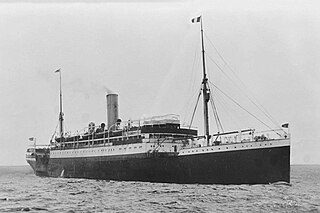
SS Fürst Bismarck was a Hamburg America Line (HAPAG) ocean liner. She was launched in Scotland in 1905. In 1914 she was renamed Friedrichsruh. In 1919 the United Kingdom seized her as World War I reparations. In 1921 Messageries Maritimes acquired her and renamed her Amboise. She was scrapped in Italy in 1935.

SS Potsdam was a steam ocean liner that was launched in Germany in 1899 for Holland America Line. In 1915 Swedish American Line acquired her and renamed her Stockholm.

SS Noordam was a steam ocean liner that was launched in Ireland in 1901 and scrapped in the Netherlands in 1928–29. Holland America Line owned her throughout her career. From 1923 to 1924 Swedish American Line chartered her and renamed her Kungsholm.

USS Covington (ID-1409) was a German transatlantic ocean liner that was launched in 1908 for the Hamburg America Line (HAPAG) as Cincinnati. In 1917 the United States seized her, had her converted into a troop ship and renamed her Covington. In 1918 SM U-86 torpedoed her, killing six of her complement. Three tugs towed her about 1/3 the way to Brest, but she sank the afternoon of 2 July 1918.

USS Rijndam (ID–2505) was the Holland America Line (HAL) ocean liner Rijndam, also spelt Ryndam, which was launched in Ireland in 1901 and scrapped in the Netherlands in 1929. The US requisitioned her as the United States Navy troopship USS Rijndam from 1918 until 1919. She was the first of four Holland America Line ships to be called Ryndam.
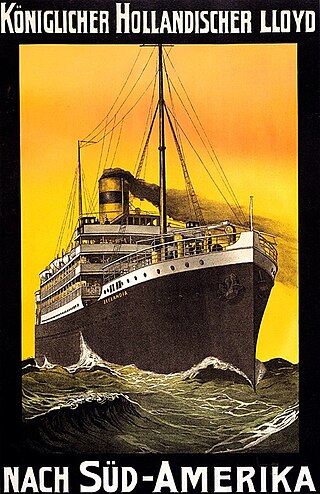
USS Zeelandia was an ocean liner that was built in Scotland in 1910 and scrapped in the Netherlands in 1936. She was the largest ship in the Koninklijke Hollandsche Lloyd (KHL) fleet from 1910 until the liners Gelria and Tubantia were completed in 1913 and 1914. She was USS Zeelandia from April 1918 until October 1919, when she was a United States Navy troopship.

SS Ypiranga was a cargo liner that was launched in Germany in 1908 for the Hamburg America Line (HAPAG). In 1919 the United Kingdom seized her for World War I reparations. In 1921 Anchor Line acquired her and renamed her Assyria. In 1929 the Companhia Colonial de Navegação (CCN) bought her and renamed her Colonial. In 1950 she was sold for scrap, but she sank off the coast of Scotland while being towed to a scrapyard.
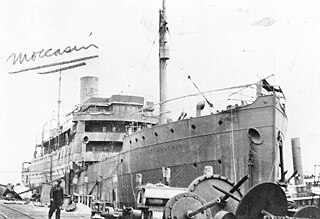
USS Moccasin (ID-1322) was a cargo liner that was launched in Germany in 1903 as Prinz Joachim. The US seized her in 1917. In 1918–19 she was renamed Moccasin and briefly served in the United States Navy. In 1920 she was returned to US merchant service and renamed Porto Rico. She was scrapped in 1933 or 1934.

USS General W. C. Gorgas (ID-1365) was a cargo liner that was launched in Germany in 1902 as Prinz Sigismund for the Hamburg America Line. In 1917 the USA seized her and renamed her General W. C. Gorgas. In 1945 she was transferred to the Soviet Union, which renamed her Mikhail Lomonosov. She was scrapped in March 1958.

USS General G. W. Goethals (ID-1443) was a German cargo liner that the United States seized during the First World War. She was launched in 1911 for the Hamburg America Line (HAPAG) as Grunewald. In 1917 the US seized her in Panama, and the Panama Canal Railway (PCR) operated her for the United States Shipping Board (USSB). In 1919 she spent six months in the United States Navy. In 1920 the PRC bought her from the USSB. In 1925 the Black Star Line owned her. In 1926 the Munson Steamship Line bought her and renamed her Munorleans. She was scrapped in Scotland in 1937.

Kronprinzessin Cecilie was a Hamburg America Line (HAPAG) ocean liner. She was launched in Schleswig-Holstein in 1905. Her scheduled route was between Hamburg and Mexico.
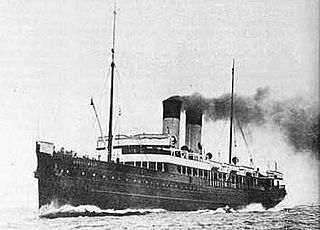
SS Copenhagen was a North Sea passenger ferry that was built in Scotland in 1907. She was the Great Eastern Railway (GER)'s first turbine steamship. In 1916 she was requisitioned as an ambulance ship. A U-boat sank her in 1917 with the loss of six lives.

SS Otsego was a cargo liner that was launched in Germany in 1901 as Prinz Eitel Friedrich. The USA seized her in 1917 and renamed her Otsego. In 1919 she served in the United States Navy as USS Otsego (ID-1628). She spent the 1920s and 30s in merchant service as Otsego. In 1941 she became the United States Army ship USAT Otsego. In 1945 she was transferred to the Soviet Union, which renamed her Ural. In 1947 she may have been renamed Dolinsk. She was either hulked or scrapped in 1955.
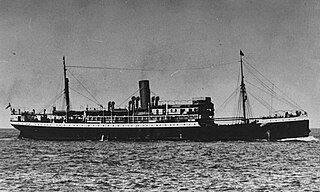
SS Prinz Waldemar was a steam cargo liner built in 1902 by the Reiherstieg Schiffswerfte & Maschinenfabrik of Hamburg for Hamburg America Line (HAPAG). She was named after Prince Waldemar of Prussia. The ship was primarily employed as a passenger and cargo carrier between Hamburg and South America during her career.

SS Grampian was a transatlantic ocean liner that was built in Scotland in 1907 and scrapped in the Netherlands in 1925. She was operated originally by Allan Line, and later by Canadian Pacific Steamships. In the First World War she remained in commercial service but carried Canadian troops. In 1919 she survived a collision with an iceberg. In 1921 she was gutted by fire while being refitted. The refit was abandoned, and in 1925–26 she was scrapped.
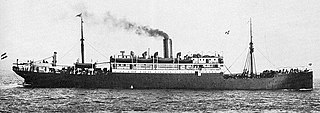
SS Prinz Oskar was a twin-screw cargo liner that was launched in Germany in 1902 for Hamburg America Line (HAPAG). She served various transatlantic routes between Europe and the Americas until the First World War began.

SS Prinz August Wilhelm was a Hamburg America Line (HAPAG) cargo liner that was launched in Germany in 1902 and scuttled in Colombia in 1918. Her original route was between Hamburg and Mexico. From 1906 she served routes between New York and the Caribbean.

SS Lima was a passenger and cargo steamship that was launched in England in 1907 as Westerwald for Hamburg America Line (HAPAG)'s Caribbean services. Portugal seized her in 1916, renamed her Lima, and used her as a troopship. By 1926 the Empresa Insulana de Navegação (EIN) had bought her for its service to Madeira and the Azores. She was scrapped in Portugal in 1969.

SS Frankenwald was a passenger and cargo steamship that was launched in England in 1908 for Hamburg America Line. In 1919 France seized her as part of Germany's World War I reparations. In 1920 the Compagnie de Navigation Paquet bought her and renamed her Tadla. A Turkish shipowner bought her in 1934 and renamed her Tari. She passed through a succession of Turkish owners, and was scrapped in 1967.























